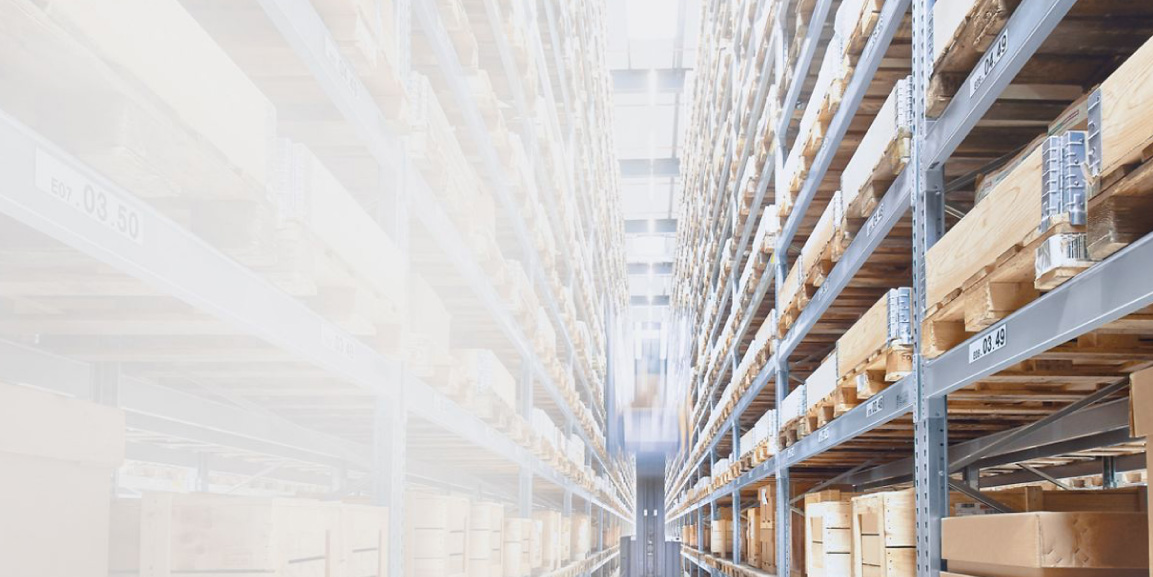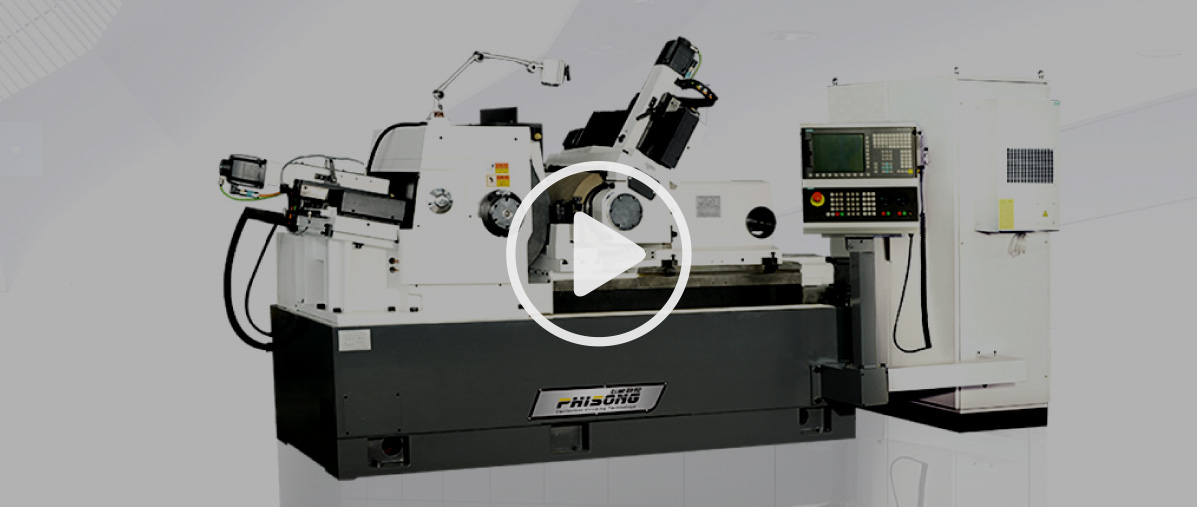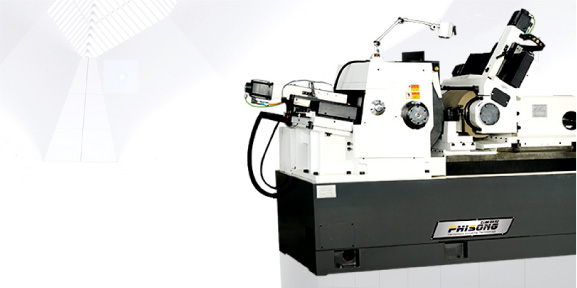

Dynamics
A comprehensive list of common defects and solutions for Centerless Grinding machines products, come and take a look!
Release time:2021-03-24
Centerless Grinding machines is a type of grinding machine that does not require the use of the axis of the workpiece for grinding. It consists of three mechanisms: grinding wheel, adjusting wheel, and workpiece support. The common grinding defects and elimination methods of centerless grinding machines are summarized as follows:


1、 Parts are not round
Reason for occurrence
(1)The guide wheel has not been rounded
(2)The grinding frequency is low or the ellipse in the previous process is too large.
(3)Blunt grinding wheel
(4)Excessive grinding or cutting amount
Elimination methods
(1)Repair the guide wheel and wait for it to finish rounding (usually until there is no intermittent sound)
(2)Appropriately increase the number of grinding cycles
(3)Repair the grinding wheel
(4)Reduce wear and heavy tool speed
2、 The parts have a polygonal shape (polygon)
Reason for occurrence
(1)The center height of the parts is not high enough
(2)The axial thrust of the component is too large, causing it to tightly press against the stop pin and unable to rotate evenly
(3)wheel unbalance
(4)The center of the component is too high
Elimination methods
(1)Accurate forward centering of parts
(2)Reduce the inclination angle of the grinder guide wheel to 0.5 ° or 0.25 °. If blocking cannot be solved, the balance of the pivot point needs to be checked.
(3)Balanced grinding wheel
(4)Properly reduce the center height of the parts
[WeChat for metal processing, good content, worth paying attention to]
3、 Vibration marks on the surface of the parts (i.e. fish colored and straight white lines appearing on the surface of the parts)
Reason for occurrence
(1)Machine tool vibration caused by unbalanced grinding wheel surface
(2)Moving forward at the center of the component causes it to bounce
(3)The grinding wheel is dull or the surface of the grinding wheel is too polished
(4)The rotation speed of the guide wheel is too fast
Elimination methods
(1)Carefully balance the grinding wheel
(2)Properly reduce the center of the parts
(3)Grinding wheel or appropriately increasing the grinding wheel dressing speed
(4)Reduce the speed appropriately
4、 The parts have a taper
Reason for occurrence
(1)Due to excessive low busbars on the front guide plate or the inclined surface of the front guide plate towards the guide wheel, the front part of the component is small
(2)Due to the low surface of the rear guide plate and the guide wheel busbar, or the inclination of the rear guide plate towards the guide wheel, the rear of the part is small
(3)Due to the following reasons, the front or rear of the component may experience a taper
①The grinding wheel has a taper due to incorrect dressing
②The surface of the grinding wheel and guide wheel is worn out
Elimination methods
(1)Properly move the front guide plate and adjust it to be parallel to the guide wheel busbar
(2)The guide surface of the adjusted guide plate is parallel to the guide wheel busbar and on the same line.
①Adjust the angle of the grinding wheel modification according to the direction of the taper of the part
②Grinding wheel and guide wheel [WeChat for metal processing, good content, worth paying attention to]

5、 The center of the component is larger and the two ends are smaller
Reason for occurrence
(1)The front and rear guide plates are evenly inclined towards one side of the grinding wheel
(2)Grind the grinding wheel into a waist drum shape
Elimination methods
(1)Adjust the front and rear guide plates
(2)Modify the grinding wheel, and do not make excessive adjustments each time
6、 There are circular thread lines on the surface of the parts
Reason for occurrence
(1)The front and rear guide plates protrude from the surface of the guide wheel, causing the parts to be scraped by the edge of the guide wheel at the outlet or inlet
(2)The support ratio is too soft, and the ground cutting is embedded on the support ratio bearing surface to form protruding burrs, which are engraved into thread lines on the surface of the part
(3)The coolant is not clean and there are chips or sand particles inside
(4)At the exit, due to the large amount of grinding, it is scraped and ground by the edge of the grinding wheel
(5)The center of the part is lower than the center of the grinding wheel, resulting in greater pressure and causing sand particles and chips to stick to the support hair
(6)Blunt grinding wheel
(7)Excessive allowance or rough grinding of the grinding wheel, resulting in extremely fine thread lines on the surface of another component
Elimination methods
(1)Adjust the front and rear guide plates
(2)Replace the surface lubrication with higher hardness bristles
(3)Replace the coolant
(4)Make the edge of the grinding wheel rounded, so that the 20mm radius at the exit of the part is not ground
(5)Appropriately advance the center height of the component
(6)grinding wheel
(7)Properly reduce wear and slow down modification speed
7、 Cut off a small piece at the front of the part
Reason for occurrence
(1)The front guide plate protrudes from the surface of the guide wheel
(2)The front end of the grinding wheel and the guide wheel are not in a straight line and differ greatly.
(3)Too much grinding at the entrance
Elimination methods
(1)Move the front guide plate back a bit
(2)Replace or modify the longest of the two
(3)Reduce the amount of grinding at the entrance
8、 The middle or tail of the part is cut, and there are several types of cuts:
1. The incision is rectangular
Reason for occurrence
(1)The excellent surface of the rear guide plate prevents the rotation of the parts and the grinding of the tread surface from continuing
(2)The extension of the rear support pad is too long, and the worn parts have not fallen off, which prevents the rotation and advancement of the worn parts
Elimination methods
(1)Move the rear guide plate back appropriately
(2)Reinstall the support pad [WeChat for metal processing, good content, worth paying attention to]
2. There are angular or many micro shaped marks on the incision
Reason for occurrence
(1)The rear guide plate is behind the surface of the guide wheel
(2)The center of the component is moving too high, causing the component to bounce at the exit
Elimination methods
(1)Move the rear guide plate slightly forward
(2)Properly reduce the center height of the parts
9、 The surface brightness of the component is not zero enough
Reason for occurrence
(1)The inclination angle of the guide wheel is too large, causing the cutting amount of the parts to be too fast.
(2)The speed of modifying the grinding wheel is too fast, and the surface of the grinding wheel is not shiny after modification
(3)The modification of the guide wheel is too thick
Elimination methods
(1)Reduce the inclination angle
(2)Reduce modification speed and modify the grinding wheel from scratch
(3)Repair the guide wheel
Note: When the grinding wheel is not started, it is forbidden to open the coolant. If the coolant is opened first, in order to prevent the occurrence of faults, intermittent driving (i.e. on, off, on, off) should be adopted to wait for the coolant to dissipate from the surroundings before starting work.
In addition, the metal processing editor has also collected some precautions for operating the centerless grinder for your reference~
Characteristics and Safety Operating Procedures of Centerless Grinding machines Grinding
Centerless cylindrical grinding is performed on a centerless grinder, where the workpiece is placed between a guide wheel and a grinding wheel. One grinding wheel serves as the grinding wheel, while the other serves as the transmission wheel, known as the guide wheel. The lower part of the workpiece is supported by a pallet. The guide wheel is made of rubber binder, and its axis forms a θ angle with the grinding wheel in the vertical direction, driving the workpiece to rotate and feed.
When using centerless grinding, the grinding wheel rotates at a circumferential speed about 75 times greater than the guide wheel. Due to the frictional force between the workpiece and the guide wheel being greater than the frictional force between the workpiece and the grinding wheel, the tolerance level of the workpiece after being driven and ground by the guide wheel is IT6~IT7, and the surface roughness value reaches Ra0.8~0.01um.
1. When manually grinding workpieces, the distance between the hand and the grinding wheel should be at least 50 millimeters, and should not be held too tightly.
2. When feeding with a push rod, hold the push rod firmly and do not use metal rods.
3. When adjusting the grinding amount, the number of trial grinding workpieces should not be less than 3.
4. When correcting the grinding wheel, it is necessary to slowly feed and provide sufficient coolant to prevent damage to the diamond.
5. When the workpiece tilts in the middle of the grinding wheel, emergency stop is required.
6. When grinding bar materials, it is required that the center between the material support frame and the grinding wheel and guide wheel be in a straight line. Grinding and bending materials are strictly prohibited.
7. Do not remove the workpiece until it has been ground out by the grinding wheel. When holding the workpiece by hand, quickly grasp it and stop its rotation.
8. The workpieces on the shelf should be placed properly to prevent them from rolling and injuring people.
9. Wear gloves when installing the spiral wheel; Take the inner hole of the end face of the spiral wheel, and do not take the outside of the spiral wheel.
10. The blade of the Heartless Sharpener Board should be sharpened to prevent cutting through the hand.
11. Do not add large materials that exceed the specifications. When large materials are found, they should be taken out immediately to prevent accidents.
12. The replacement of grinding wheels should follow the general safety regulations for grinders.
The following precautions should be taken when operating a centerless grinder:
(1)Before starting up, check the surrounding condition of the machine. No items should be placed on the machine, and the workpieces should be arranged neatly. [WeChat for metal processing, good content, worth paying attention to]
(2)Before starting up, check whether the parking space of the container is normal, the water level of the cooling water tank, the gap between the grinding wheel and guide wheel and the supporting blade are normal, and whether there are any working objects or debris in the machine tool.
(3)Before starting up, check whether the switch is reliable and confirm whether the safety protection of the protective cover is effective.
(4)Turn on the power, activate the hydraulic switch, observe whether the pressure on the hydraulic gauge of the machine tool is normal, and then check whether there is oil flowing through each mirror and pipe.
(5)Before starting up, the grinding wheel and guide wheel dressing seat must be wiped clean, and the cup must be filled with oil.
(6)Before starting up, the operator must be trained according to the operation manual to understand the various work operation procedures.
(7)After the above confirmation is correct, the machine can be turned on.
(8)Turn on the main power to the ON position. 09: Turn on the hydraulic switch to the ON position.
(9)Check the hydraulic system mirror and stabilize the oil gauge before starting the grinding wheel and guide wheel.
(10)After the grinding wheel and guide wheel are running normally, turn on the water pump and adjust the water volume to the appropriate level.
(11)Adjust and grind 1-3 workpieces, first check the size and appearance of the workpieces, and place the adjusted products in the adjustment box.
(12)Adjust and grind 1-3 workpieces, first check the size and appearance of the workpieces, and place the adjusted products in the adjustment box.
(13)Batch production can only be carried out after passing the inspection.
(14)After starting production, the operator must perform self inspection on the first sample according to the operation manual and record it.
(15)When abnormalities occur during the production process, the machine should be immediately stopped and reported, and relevant forms should be filled out.
(16)When shutting down, turn the water pump motor switch to the OFF position to stop the water supply and remove the work object stuck in the machine tool.
(17)The grinding wheel and guide wheel should idle continuously for more than 5 minutes to stop the water supply and prevent the grinding wheel from becoming unbalanced when restarted. After drying the water, turn off the power switch of the grinding wheel and guide wheel.
(18)After the grinding wheel and guide wheel have stopped, the oil pressure switch can be turned to the OFF position (do not stop the oil pressure motor first to avoid oil loss and wear on the bearing and spindle).